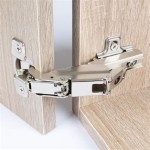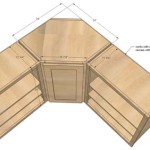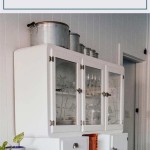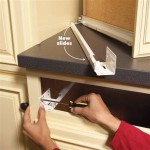Organizing Kitchen Cabinets: A Strategic Approach to Placement
Effective kitchen organization is crucial for efficient food preparation and a stress-free culinary experience. A primary aspect of kitchen organization involves optimizing the arrangement of items within kitchen cabinets. The principle of "everything in its place" transforms a cluttered and chaotic space into a functional and aesthetically pleasing environment. Strategic placement, based on frequency of use and item category, enhances accessibility and streamlines workflows.
The first step in organizing kitchen cabinets is a thorough decluttering process. All items within the cabinets should be emptied and assessed. Expired food, broken utensils, and duplicates that are no longer needed should be discarded or donated. This allows for a clear understanding of the available space and the actual inventory requiring storage.
Once decluttering is complete, the next phase involves cleaning the cabinet interiors. Wiping down shelves and drawers with a mild cleaning solution eliminates dust, crumbs, and potential food residues. This creates a hygienic environment for storing food and kitchenware and prevents the attraction of pests.
Subsequently, categorize the remaining items based on function and usage. Common categories include food storage, cookware, bakeware, dishes, glassware, utensils, and cleaning supplies. This categorization forms the foundation for strategic placement within the cabinets, ensuring that frequently used items are easily accessible and less frequently used items are stored in less convenient locations.
Prioritizing Accessibility: High-Frequency Items
The placement of frequently used items should prioritize accessibility. Items used daily or several times a week should be located in easily reachable areas, typically within arm's reach and at eye level. This minimizes the need for bending, stretching, or searching, saving time and effort during food preparation and cleanup.
Dishes and glassware used for daily meals should be stored in cabinets closest to the dishwasher or sink. This simplifies the unloading process and reduces the risk of breakage. Similarly, commonly used cooking utensils, such as spatulas, spoons, and whisks, should be kept in a utensil holder on the countertop or in a drawer near the stovetop.
For frequently used food items, consider designating a specific shelf or cabinet within easy reach. Cereal, coffee, tea, and other breakfast staples should be grouped together for convenient access in the morning. Similarly, frequently used spices and condiments should be stored in a spice rack or designated shelf near the cooking area.
The positioning of frequently accessed items should also consider the user's height and reach. Individuals who are shorter may benefit from storing frequently used items on lower shelves, while taller individuals may find it more convenient to store them on higher shelves. Customizing the organization to individual needs enhances overall usability.
Grouping by Function: Optimizing Workflow
Grouping items by function contributes to a more organized and efficient kitchen workflow. Storing related items together streamlines food preparation and simplifies cleanup. This approach minimizes the time spent searching for ingredients and tools, allowing for a more focused and enjoyable cooking experience.
Cookware, such as pots, pans, and skillets, should be stored together, ideally near the stovetop. This allows for easy access during cooking. Consider using pot racks or hanging organizers to maximize space and improve visibility. Lids should be stored with their corresponding pots and pans, either inside the cookware or in a separate lid organizer.
Bakeware, including baking sheets, cake pans, and muffin tins, should be stored in a dedicated area, preferably near the oven. This simplifies the baking process and prevents the need to search for specific items. Consider using vertical dividers to separate baking sheets and prevent them from stacking and becoming difficult to retrieve.
Food storage containers should be organized by size and type, with lids stored separately in a designated container or drawer. This prevents the frustration of searching for matching lids and ensures that containers are readily available for storing leftovers and meal prepping. Clear containers allow for easy identification of contents, minimizing food waste and maximizing storage efficiency.
Cleaning supplies, such as dish soap, sponges, and cleaning cloths, should be stored in a designated cabinet under the sink or in a separate cleaning supply caddy. This keeps cleaning supplies separate from food and cooking items, maintaining hygiene and preventing contamination. Ensure that cleaning supplies are stored out of reach of children and pets.
Maximizing Space: Vertical Storage and Shelf Organizers
Maximizing vertical space within kitchen cabinets is crucial for optimizing storage capacity. Utilizing shelf organizers, risers, and tiered shelves effectively increases the available storage space and improves visibility. This allows for storing more items without overcrowding or cluttering the cabinets.
Shelf organizers can be used to create additional levels within cabinets, effectively doubling or tripling the available storage space. These organizers are particularly useful for storing plates, bowls, and glasses, allowing for stacking without the risk of breakage. Wire or plastic shelf organizers are readily available in various sizes and configurations to suit different cabinet dimensions.
Risers can be used to elevate items, providing a clear view of items stored behind them. This is particularly useful for storing spices, canned goods, and other small items that can easily get lost in the back of cabinets. Tiered shelves offer a similar benefit, allowing for arranging items in a stair-step fashion for improved visibility and accessibility.
Vertical dividers can be used to separate baking sheets, cutting boards, and other flat items, preventing them from stacking and becoming difficult to retrieve. These dividers can be made of wood, metal, or plastic and are easily installed within cabinets. They provide a neat and organized solution for storing items that would otherwise take up a disproportionate amount of space.
Utilizing the backs of cabinet doors for storage can also maximize space. Over-the-door organizers are available for storing spices, cleaning supplies, and other small items. These organizers provide additional storage without taking up valuable shelf space. However, it is imperative to ensure that the cabinet door can still close properly after installing the organizer; otherwise, the items placed there will interfere with the closing.
Drawer organizers are crucial for maintaining order within drawers. Compartmentalized organizers can be used to separate utensils, silverware, and cooking tools, preventing them from becoming tangled or disorganized. Non-slip liners can be used to prevent items from sliding around within drawers, reducing noise and preventing damage.
Rotating organizers, such as lazy Susans, are particularly useful for storing items in corner cabinets or deep cabinets where access can be challenging. These organizers allow for easily accessing items stored in the back of the cabinet without having to reach or rummage through other items. Lazy Susans are available in various sizes and materials to suit different cabinet dimensions and storage needs.
Proper labeling enhances kitchen organization. Clearly labeled containers and shelves make it easier to find items and maintain order. Labels can be handwritten, printed, or created using a label maker. Consistent labeling throughout the kitchen contributes to a more organized and efficient environment. These labels should be regularly updated and the items or food should be stored in the proper order based on their labels.
By implementing these strategies, organizing kitchen cabinets becomes a systematic process that optimizes space, enhances accessibility, and streamlines kitchen workflows. The result is a more functional and enjoyable cooking environment.

S Sweet World How To Organize Your Kitchen Cabinets Into Zones Maximize Functionality

How To Organize Kitchen Cabinets

How To Organize Your Kitchen Cabinets And Pantry Feed Me Phoebe

25 Best Ideas For How To Organize Kitchen Cabinets

How To Organize Your Kitchen Cabinets In 3 Simple Steps Practical Perfection

46 Kitchen Cabinet Organization Ideas Lady Decluttered

How To Organize Kitchen Cabinets Step By Declutter

How To Organize Your Kitchen Cabinets And Pantry Feed Me Phoebe

Organizing Kitchen Cabinets In Five Easy Steps Town Country Living

How To Organize Kitchen Cabinets In 9 Simple Steps Trusted Since 1922
Related Posts








